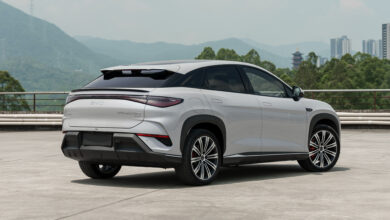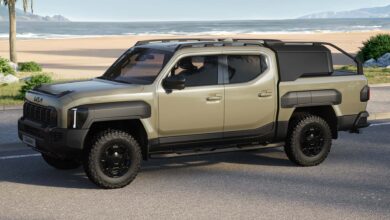REVIEW: 2023 Honda WR-V RS – driving the Ativa rival
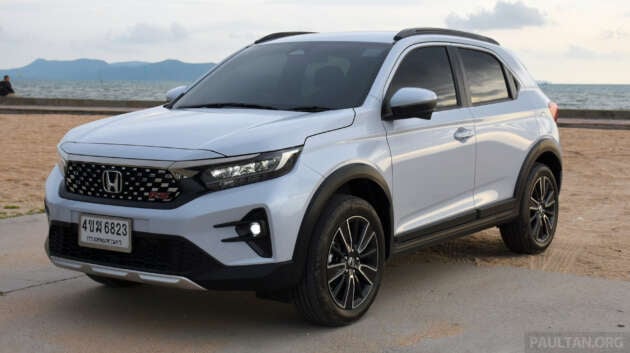
[ad_1]
Opening up a new card doesn’t guarantee the draw will ensure commercial success, especially when it involves going into an unfamiliar arena, but Honda Malaysia is banking on the Honda WR-V’s arrival into the entry-level SUV segment giving it a winning hand.
UPDATE: The 2023 Honda WR-V has been officially launched in Malaysia. Four variants (S, E, V and RS) of the compact SUV go on sale here.
The second-generation WR-V or Winsome Runabout Vehicle is due to be introduced here soon, sometime in the third quarter of the year. Introduced last November, the DG4 marks the automaker’s entry into the small SUV game in the region, its advent largely brought about by Honda’s desire to compete in the segment against rivals such as the Toyota Raize and Daihatsu Rocky in Indonesia.
Closer to home, it will go head-to-head against the Perodua Ativa, and its debut here comes at the expense of the BR-V, which has been dropped from the local line-up. The switch away from the latter, which offered Honda buyers a seven-seater option, sounds like a bit of a gamble, but the company is hoping that the shift in focus away from the very competitive seven-seater game will pay dividends.
Ahead of its arrival here, Honda Malaysia provided the chance to sample the Honda WR-V in Thailand, doing so on a two-day drive from Bangkok to Pattaya. How does the second iteration of the nameplate shape up?
Let’s find out.
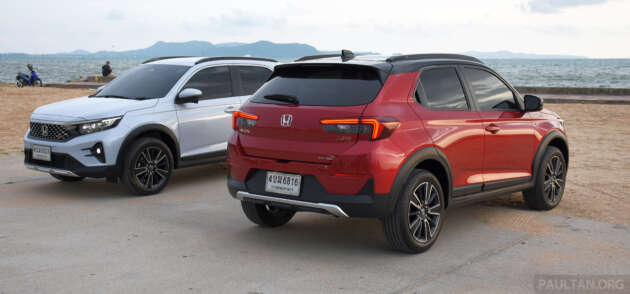
Sharp suit
Comparisons of the Honda WR-V against the Ativa are inevitable because of how both models sit in the same class/category, if not in price (more on this later). As such, you’ll find suitable references throughout the review, with my observations gleaned as an Ativa owner, having purchased an AV variant last September as a replacement for a long-serving Ford Fiesta.
First up, dimensions. The Honda WR-V, which sits on a shortened second-gen BR-V platform, measures in at 4,060 mm long, 1,780 mm wide and 1,608 mm tall, with a 2,485 mm-long wheelbase. Comparatively, the Ativa is 4,065 mm long, 1,710 mm wide and 1,635 mm tall, and has a 2,525 mm-long wheelbase, making it five mm longer and 27 mm taller but 70 mm narrower than the Honda. While the Ativa has a 40 mm longer wheelbase, its ground clearance is lower at 200 mm compared to the WR-V’s 220 mm.
Although similar in size, the Honda WR-V feels the more compact of the two visually, and not in a bad way, because it is the more vibrant looking of the duo. The WR-V’s lines works very well in the metal, with the shape having a good, muscular appeal about it from most angles (the rear does look a bit soft compared to the front and sides). If you’re not into wedge-styled faces, the RS’ front, with its chrome chequered grille, will look especially sharp to the eye.
In this regard, the younger crowd is bound to be taken by the sporty depiction, which also features a Volvo-esque C-pillar flow, certainly more so than if the design pitch had been styled along the lines of the recently announced Elevate, which uncannily resembles the Perodua in certain design areas.
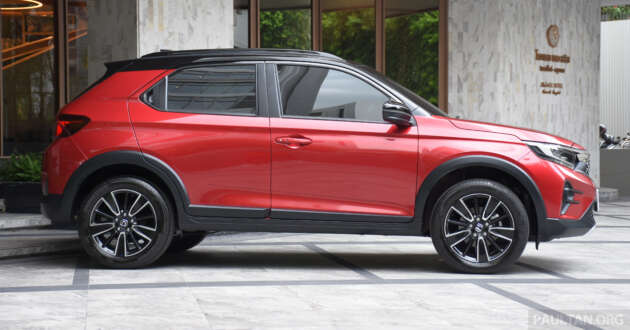
The evaluators in Thailand were all RS variants, with three exterior colours available for the five units that were in service. Of the shades, the two-tone Ignite Red Metallic with black roof – unique to the RS – arguably shows the Honda WR-V off best, but the Stellar Diamond Pearl isn’t far behind. Oh, a word about the roof rails – they’re nice and add flair to the presentation, but are merely decorative plastic units to enhance the aesthetics.
Kit and specifications
A quick recap of the trims and kit available for the Honda WR-V in Thailand and Indonesia. The thing to note is that while they differ somewhat in terms of equipment specification, the cars sold in both markets are assembled in Indonesia by PT Honda Prospect Motor. Of course, our WR-V will be assembled here in Melaka.
Standard equipment on the WR-V in Thailand include automatic LED headlamps, LED DRLs, LED taillights with sequential turn signals, body coloured door handles, black synthetic leather/fabric combination seat upholstery and leather steering wheel (both with blue contrast stitching), remote engine start, walk-away auto lock and keyless entry/push-start ignition.
Also on, automatic air-conditioning, a seven-inch touchscreen head unit with Apple CarPlay and Android Auto support, Siri and Android Auto voice control, four speakers, two USB ports, multi-angle rear-view camera, a Honda Smart Key Card and a 4.2-inch TFT multi-info display. That’s on the SV, which rides on 16-inch five spoke alloys, wrapped with 215/60 profile tyres.
The RS gets additional kit on top of its exterior dress-up elements. These include red accent trim and red contrast stitching on the upholstery and steering wheel, a rear seat armrest, paddle shifters and two extra speakers to bump up the count to six. It also adds on a Honda Connect telemetry system, LED front fog lamps, auto folding side mirrors and ups the wheels to 17-inch two-tone units, which are shod with 215/55 rubbers.
In terms of safety and driving assistance, the Honda WR-V has vehicle stability assist and hill-start assist, and the SV gets four airbags (front, side), with the RS adding on side curtain airbags to make it six.
Honda Sensing is standard in Thailand, with the ADAS item list comprising collision mitigation braking (CMBS), road departure mitigation with lane departure warning (RDM with LDW), adaptive cruise control (ACC), lane-keeping assist (LKAS), lead car departure notification and auto high-beam. Missing from the list however is the low-speed follow function.
Additionally, the Honda WR-V RS comes with the automaker’s LaneWatch side camera system. While it works, it is starting to show its age when pitched against a standard blind spot warning system such as that on the Ativa.
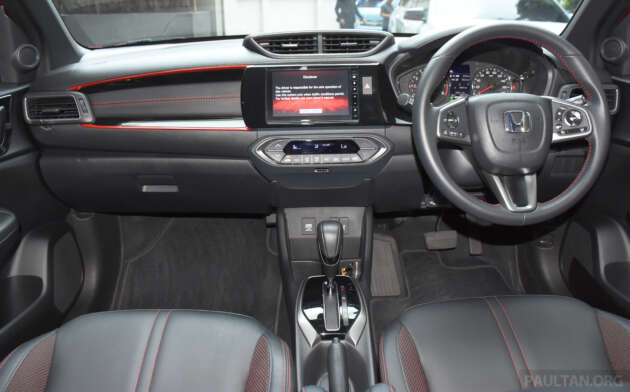
It remains to be seen the number of Honda WR-V variants Honda Malaysia will introduce aside from the RS. The range-topper is a given, but the possibility of there being more than one other variant for our market (entry, mid-spec, RS) is there.
This is suggested by the Indonesian E grade, which is the base model in the republic. The version pares down the kit compared to the base Thai SV. It comes with halogen headlamps (without auto feature), fabric seats, digital air-conditioning, a MID instrument display and omits the walk-away auto lock function, among other things. Will we get more than two variants? It’s still unknown if we’ll get low- and mid-spec variants, but we’ll find out soon enough.
Plenty of traditional vibes
If the dashboard looks familiar, it is, almost lifted wholesale from the second-gen Amaze sedan and second-gen BR-V. Visually, the cabin looks pleasant and contemporary at first glance, but there’s quite a bit of a traditional structure about things upon closer inspection.
For one, there’s the instrument cluster, which remains analogue in its readouts save for the 4.2-inch TFT screen housed in the middle of the binnacle. Nothing wrong with that in terms of legibility, but the more tech-oriented will point to digital surely being the way forward in this day and age, as in the case of the Ativa.
The Honda WR-V’s parking brake remains mechanical, and the gearshift lever – and accompanying console – also features an old-school vibe. It works well enough, although a minor gripe is that its reach position sits a bit on the low side.
As for the plastics, there’s a lot of hard surfaces, even at key contact points, which takes some of the shine off the package. It’s obvious that much of it is the result of having to work towards a price point (key in a market such as Indonesia) and not because it can’t be made more premium – to wit, you only have to look at the Civic FE.
Some elements hit well above the segment though, like the illuminated courtesy mirrors on the sun visors. Available only on the RS trim, it’ll be interesting to see if that makes it on to the Malaysian-spec model. That it’s on a WR-V is surprising, when you consider that something like the fifth-gen CR-V doesn’t come with it. It may sound like a small thing, but I’m sure that many a lady would argue that it is not.
One area where it absolutely trumps the Ativa is in its infotainment system. The seven-inch Advanced Display Audio touchscreen system doesn’t have the snazziest GUI, but it’s clean in use. More importantly, its ability to handle Android Auto and Apple CarPlay edges it ahead of the Ativa in terms of functionality. Couple that to an audio system that is simply miles ahead of the Perodua’s low-fidelity set-up, and it isn’t even a contest.
Of seating, space perception and other related areas
In line with the size of the cabin, the front seats aren’t all that large – they seat well enough, albeit with rather aggressive lumbar support, but sacrifice thigh support to provide improved access for leg ingress. In the interest of providing usable knee room for rear occupants, they also don’t slide back as far as a tall driver – or front passenger – may like.
Rear occupant space is decent, but naturally not at the levels seen in larger Honda models, in which cavernous space is always touted as a plus point. In the case of the Honda WR-V, it is what it is, an A-segment/small-B offering, and it shows. Large frame occupants can still fit in with adequate headroom, as seen in the photo above, and if you’re of a smaller disposition then you’ll definitely get some space to play with. In terms of headroom, the taller Ativa inches the win, space perception undoubtedly aided by lighter coloured headlining.
Elbow-to-elbow distance room is marginally better than that in the Perodua, but the added width of the WR-V also translates to the absence of one anomaly I find rather irritating in the Ativa, that of the seat belt buckle clearance in relation to the outer side of the front seats.
On the Perodua, there’s very little clearance between the B-pillar trim and the sides of the seat, and so when the belt is retracted back after use, the buckle can get caught in between the seat and trim, clunking about when the car is on the move, which is usually the case with the passenger side unit. The additional width on the Honda means the buckle goes back in place without catching wrongly. Small win, sure, but there it is.
However, the Honda WR-V has its own peculiarities. Those who find storage on seat backs a useful thing, take note that you’ll only have one storage flap on the Honda, on the front passenger seat (Ativa has on both front seats). Elsewhere, rear occupants needing to charge their mobile devices will have to use a 12V USB adapter, because the WR-V only has two USB ports, located in the front. With four slots (two front, two rear), the Perodua is ahead on the USB count.
Finally, boot space. With 380 litres available, the WR-V has 11 litres more space than the Ativa, which presents 369 litres of usable space with its deck set on the lower tier position (303 litres with the panel in upper tier). Now, while there’s technically a bit more storage space in the WR-V, it’s not likely to be discernible in actual use.
The more pertinent question is how one will hide the contents in the Honda’s boot from prying eyes. That’s because it has no privacy cover/screen, or even a provision for one. Where the Ativa has inserts on the rear trim for its foldable screen, there’s no such cutout on the WR-V. Adopting the HR-V’s approach of integrating its removable screen into the tailgate would solve the issue, but there didn’t look to be any mounting points for such a solution.
Because they were so heavily tinted, it wasn’t obvious at first on the Thai evaluators, but you can imagine the peek-a-boo games otherwise. Turning your rear screen into a panel van via tint film may not be everyone’s idea of fun, but unless a fix for this pops up, it could be the only way to maintain storage privacy. According to Honda Malaysia, they’re looking into it, so a solution could be in place by the time the Honda WR-V is launched in Malaysia.
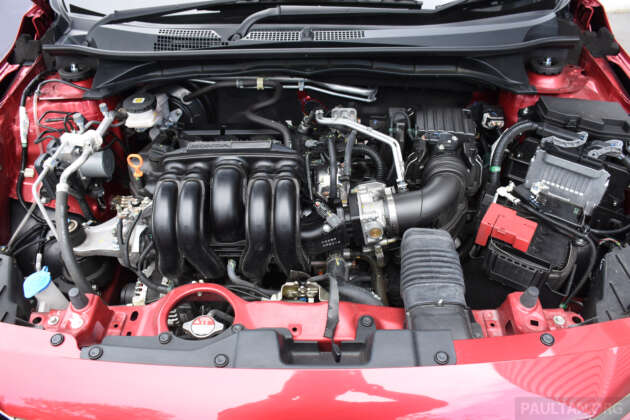
Out on the road
In both Indonesia and Thailand, the Honda WR-V is powered by a 1.5 litre naturally-aspirated DOHC engine with i-VTEC offering 121 PS at 6,600 rpm and 145 Nm of torque at 4,300 rpm, and so that’s the mill we’ll be getting too. The L15ZF is familiar, being the same as found in the City and entry-level HR-V and, like in those applications, is partnered with a CVT here.
As such, the behavioural response from the powertrain is pretty much the same. The engine is quite tractable within a city environment, and gets the job done neatly if you’re not attempting to move about in hurried fashion. Floor the pedal and engine – and CVT – responds with a wall of noise, but not much in terms of outright acceleration.
To expect blistering off-the-mark pace is missing the point with this one, because the Ativa is also pretty much the same in that regard, despite the WR-V carrying a bit more weight. The RS variant tips the scales at 1,143 kg, 108 kg more than the Ativa, which weighs in at 1,035 kg.
Ativa owners will be familiar with the raucous zing coming off the 98 PS and 140 Nm three-pot turbo when it’s asked to shove, with very little pace to be gained from such action. With more sensible input to throttle, both mills respond in more adequate fashion. There’s only one advantage the Perodua has, and that’s in its movement from low to intermediate speeds, which feels sprightlier in response with the maximum torque being available earlier down the rev range.
At higher speeds, the Honda WR-V is stable and composed, tracking with limited need for minute steering correction. There’s a bit of road noise, primarily coming off the tyres and more noticeable in the rear section of the vehicle, but this is at the higher end of the speed spectrum. If anything, I felt it to be as quiet as the Ativa (itself not a library at higher speeds) at intermediate speeds. It’ll be interesting to determine 50/80/110 km/h SPL levels in relation to the Ativa when the chance comes, if only to answer that curiousity.
As for handling, there was very little chance to try that out on the drive, with the route from Bangkok to Pattaya involving carriageways and virtually no B-roads, so the question of how well it drives away from a straight line will have to be answered later when the car gets here. The steering responds well to input, although it doesn’t have much in the way of feel.
In terms of suspension, the primary ride is clean, aiding to the stability mentioned earlier, and in an urban environment the low speed secondary ride does very well. It can get caught out by some ruts, but on the whole its setup is far less reactive than the Ativa, which can get jarring at times. Of course, much of what we were experiencing could be due to the better quality of Thai road surfaces, but I believe that in terms of low speed ride sophistication, the Honda looks to be well ahead.
Finally, a quick mention about fuel consumption, even though no one was really driving the Honda WR-V economically for the most part. On a three-driver rotation, we managed 12.3 km per litre on the first day with some hard driving, and this climbed to 14.4 km per litre on the second day.
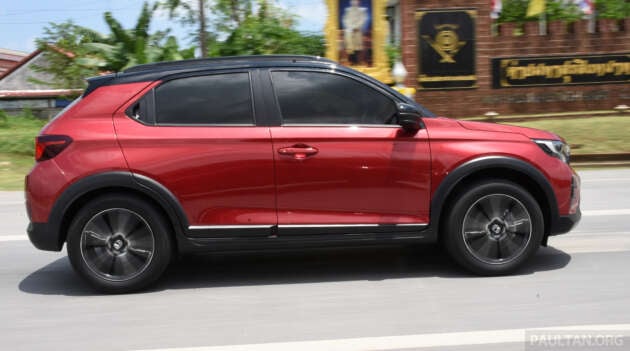
How does it measure up?
Based on the early sampling, the second-gen Honda WR-V should find plenty of takers in the market for a compact SUV from the brand. Granted, the element of working to a price point is evident in some areas, but the car performs well, has enough kit and its exterior styling has plenty of appeal, certainly enough to tick the right boxes for its intended audience, which is younger and not needing to haul a large number of occupants at a go.
To answer the question of it against the Ativa, well, neither vehicle has an absolute advantage over the other from a product or performance viewpoint, though it does go to show what great value the Ativa is. Ultimately, pricing will determine how just how well the WR-V does commercially.
In Indonesia, pricing for the Honda WR-V ranges from RM80k for the E to RM90k for the RS, while in Thailand, the SV goes for about RM106k and the RS for around RM115k under current exchange rates. While HMSB didn’t want to officially engage on that particular topic, indications are that the WR-V will be priced somewhere along the lines of the City/City Hatchback, which would put it in the RM90k plus region for starters.
This would suggest that the RS will edge closer towards the entry-level HR-V in terms of price, denting previous suggestions that the WR-V could possibly be just around RM10k more than the Ativa. However, the introduction of a base third spec could push pricing back towards that, so that aspect cannot be discounted. Still, despite the premium, you get the feeling that there will be plenty of adopters, especially among the Bangsa H crowd and those for which a Perodua badge has little or no appeal.
GALLERY: 2033 Honda WR-V RS, Thailand-spec
GALLERY: 2023 Honda WR-V, Thailand-spec, official photos
Looking to sell your car? Sell it with myTukar.
[ad_2]


